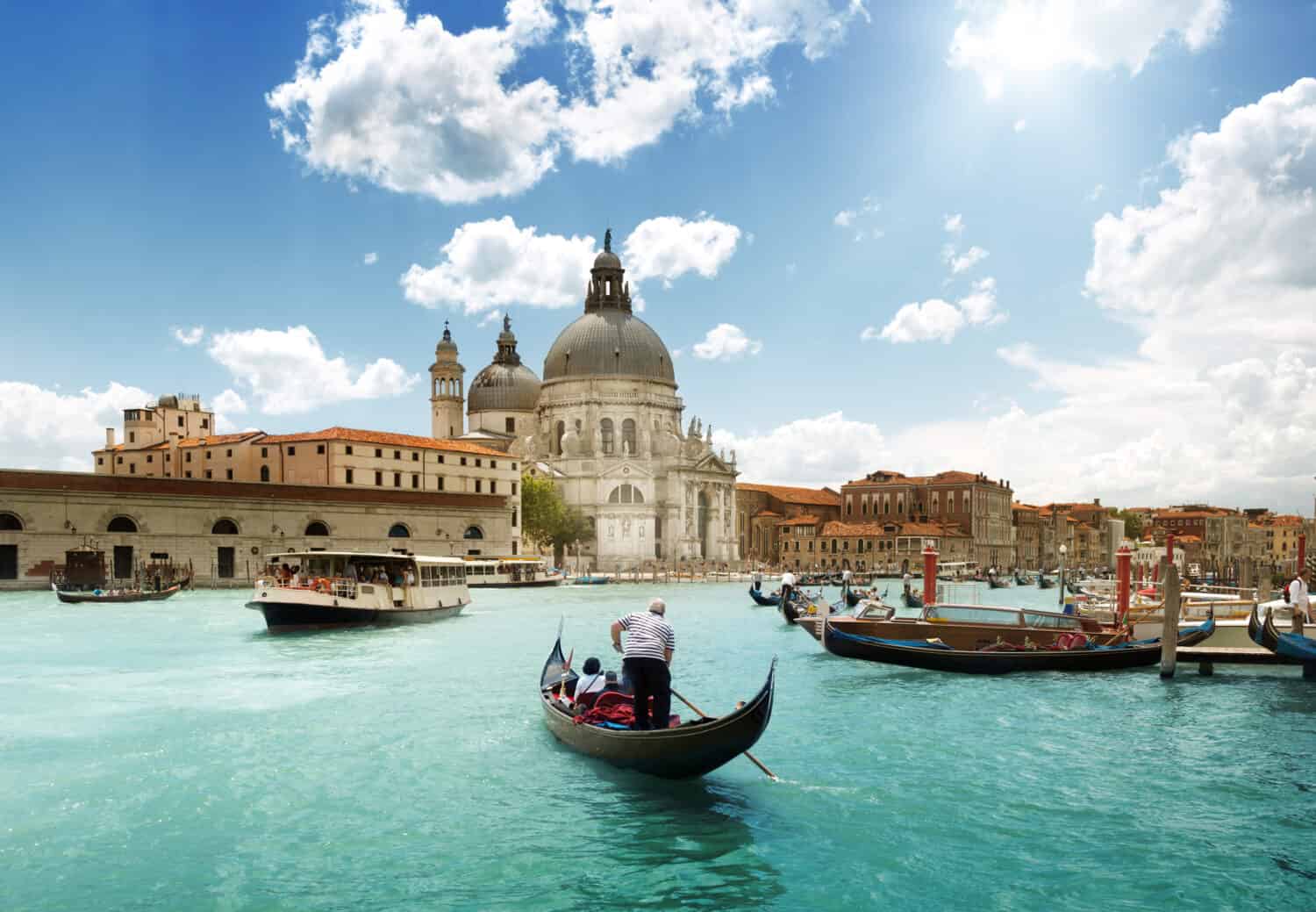Italy is one of the world’s most sought-after destinations. Known for impeccable cuisine, incredible landscapes, and rich history, it is no wonder that Italy is a top travel destination. When planning a trip here, most people’s first question is, when should I visit for the best weather?
When Is the Best Time to Visit Italy for Ideal Weather?
Italy is one of the largest countries in Europe, and it has a variety of climates. With the hottest temperature ever recorded being 119.84 degrees Fahrenheit and the coolest temperature of -57.28 degrees Fahrenheit, it is clear that there is a wide variety of climates. Italy is separated into four types of climates: Alpine, Mediterranean, Peninsular, and Po Valley climates. The best times to visit Italy for ideal weather are the months of May, June, September, and October. The large amount of tourists that flock there during those months serves as confirmation. The weather is usually warmer, sunny, and pleasant during these months.

Italy sees the highest tourism rates in May, June, September, and October.
©RossHelen/Shutterstock.com
Italy’s Most Popular Destinations and Their Climates
Although there are more popular months for the country overall, Italy is a large country with varying climates. Due to the various environments, the specific time of year that offers the ideal weather could differ depending on which region you want to visit. It could also differ depending on the weather ideal for your chosen vacation. This article will cover the top 15 most popular destinations in Italy and their climates. We will cover their average temperatures, natural hazards, and the ideal time to visit each region.
Amalfi Coast
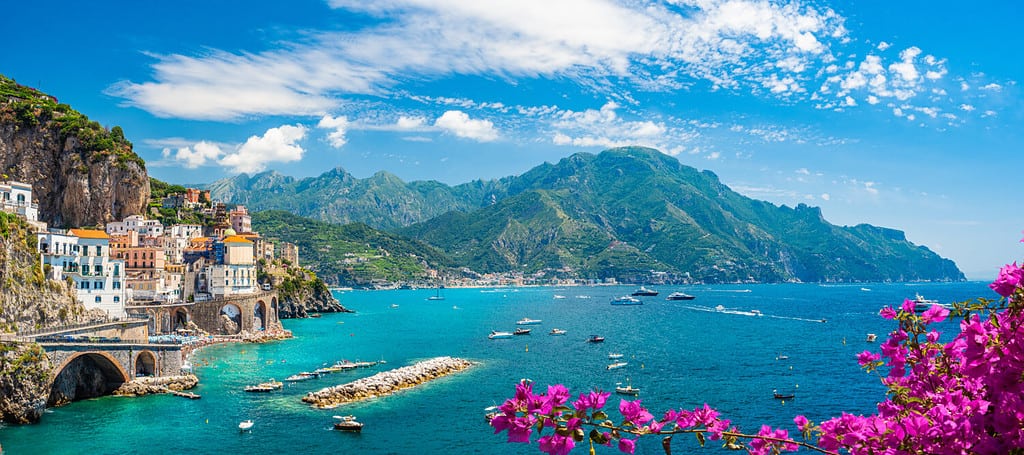
To best enjoy these incredible coastal views and stunning beaches, visit between the middle of June through early September.
©Serenity-H/Shutterstock.com
The Amalfi Coast is one of Italy’s most picturesque destinations. Located in the province of Salerno, the Amalfi Coast is known for its stunning coastal views and colorful villages. The Amalfi Coast offers a variety of landscapes and activities. However, although it is a stunning destination all year round, certain times are better to visit, depending on the activities you wish to enjoy.
Typical Climate
If you like warm weather and beach laying, then your ideal months for visiting would be between mid-June to early September. These months are considered the hot season, with the hottest month being August. The average high temperature in August is 88 degrees Fahrenheit. Suppose you prefer cooler climates and more physically demanding activities such as hiking. In that case, you may wish to visit in the colder months. February is the coldest month in Amalfi, with an average high of 56 degrees Fahrenheit.
Along with the temperature, you want to consider precipitation when traveling. While rain does fall throughout the year, there are high and low seasons. The dry season is from April 29 to September 14, and the wet season is from September 14 to April 29. The driest month is July, which averages 0.5 inches of rainfall, and the wettest month is November, which averages 3.8 inches of rain.
Best Time to Visit and Natural Hazards to Be Aware Of
While winters on the Amalfi Coast are not cold, if you are looking for the ideal time to visit, it would be in the summer. This is mainly because the most popular activities here are best done in warm weather and sunshine. There is reduced availability for many popular activities in the winter because of cooler weather, frequent rain, and fewer tourists visiting.
The Amalfi Coast is fragile. This particular region is prone to landslides for a variety of reasons. First is due to the slope of the cliffs, but also earthquakes — which Italy is prone to — and wildfires. Heat waves and droughts can cause wildfires to spark. To have the best chance at avoiding landslide possibilities, avoid seasons that offer excessive rain or heat and drought.
Bologna

Known for its incredible cuisine, medieval squares, and the world’s oldest university in continuous use, Bologna offers a rich history.
Bologna — located in northern Italy and the capital of the Emilia-Romagna region — is known for its red rooftops, many towers, and delicious foods! This region has various temperatures, ranging from hot, muggy summers to cool, damp winters.
Typical Climate
The winter months range from December to February when the climate is cool and damp with overcast. The average temperature around this time ranges from lows of 32 degrees Fahrenheit to highs of 50 degrees Fahrenheit. While winter is the drier season, snow usually falls at least once in the colder months.
Spring in Bologna can be unpredictable, much like the weather in the United States. The temperature tends to rise, but cold fronts can reappear in early spring. Rainfall and thunderstorms are more frequent during this time as well. Spring tends to last from mid-April to late May. During the autumn months, rain and overcast are also common.
Best Time to Visit and Natural Hazards to Be Aware Of
Summer is the season that most people visit here due to the sunshine and warmth. It is common for temperatures to reach 95 degrees Fahrenheit and the air can get quite humid. You should visit here late spring to early summer to find the perfect weather for your trip. This way, you avoid the last chill days of spring but arrive before the summer heat becomes overbearing.
This region has a lot of rainfall. It averages about 32.5 inches of rainfall per year. Bologna has had issues with flooding due to excessive rain. To avoid potential flooding threats, you should visit during the drier seasons. According to The Guardian, “Weather-related disasters have been on the rise in Italy, a country deemed particularly vulnerable to climate change.” Earlier this year, Bologna and the rest of the Emilia-Romagna region, suffered severe flooding. This was due to the heavy rainfall and the severe drought they had had prior, reducing the land’s ability to absorb all of the water properly.
Capri

Faraglioni cliffs and beaches make the island of Capri Italy a beautiful destination.
©Janoka82/iStock via Getty Images
Located in the Bay of Naples, this Italian island is called the Pearl of the Mediterranean. Capri is a picturesque location that gives a sense of luxury. From magnificent shopping to the infamous Blue Grotto, this island offers many breathtaking sights and activities. Although this beautiful destination is an island, it does not boast tropical weather year-round. Capri has four distinct seasons, each with their own weather patterns.
Typical Climate
In the spring months, the weather is mild and perfect for outdoor activities such as hiking and boat tours. The average temperature is in the 60-degree range. There is some precipitation and some cloud coverage. Capri is known for its summer months. Bright sunny days and warm nights offer the perfect temperature for relaxing on the beaches and enjoying a day on the sea. Although perfect for water activities, the temperatures in the summer do average in the upper 80s, so it may not be ideal for day trips that don’t offer respite from the heat. Rainfall and cloud coverage are less during the summer months as well.
Early autumn mimics spring with its mild temperatures. As it gets closer to the winter, the cool temperatures and precipitation begin to rise. November is the month that has the most rainfall, and it averages 11 days with at least 0.04 inches of rainfall. Winter is off-season in Capri as it has the coolest climate, so it only offers a little opportunity for many of the attractions offered on the island.
Best Time to Visit and Natural Hazards to Be Aware of
Many locals deem the best time to visit the island is either the beginning of April to mid-June or the beginning of September to mid-October for the perfect weather.
One natural hazard in Capri to be aware of is earthquakes. Capri has had eight earthquakes in the past year. An earthquake is the sudden shaking of the ground due to movement within the earth’s crust or volcanic activity. A common misconception is that there is a certain type of weather pattern that causes earthquakes to happen; however, that is not the case. Earthquakes happen so far underground that the weather is not a determining factor.
Instead, tectonic plates are constantly shifting under the earth’s crust. The constant movement can cause a buildup of stress, allowing cracks to form. An earthquake is produced when the earth’s crust moves along one of those cracks. Capri is so susceptible to this natural disaster because it is located in southern Italy. Southern Italy is close to the line where the Eurasian and African plates meet, and those plates constantly grind against one another creating an increased risk for earthquakes.
Dolomites

The Dolomites have 18 peaks that rise over 9,000 feet high.
©PositiveTravelArt/Shutterstock.com
Located in northeastern Italy, this mountain range is one of Italy’s most sought-after destinations. The Dolomites showcase 18 peaks, rising over 9,000 feet high. This destination is a favorite for hikers and explorers alike. The different regions of this mountain range have different climates. Areas in the south tend to have more cold spells and more fog while the northern regions offer less rain and more desirable conditions.
Typical Climate
The summer months — July through September — offer the perfect weather for hiking and cycling with warm, sunny days with highs of 80 degrees Fahrenheit. Autumn also boasts desirable temperatures for these activities. Winter snows and weather begin to accumulate in December and do not let up until March or April. Although too cold for casual hikes, the plentiful snow and sunshine make the winter months perfect for snowboarding, skiing, and other winter sports. Spring has beautiful weather, but a lot of rainfall, so it is not ideal for outdoor activities.
Best Time to Visit and Natural Hazards to Be Aware Of
When it comes to the best time to visit this glorious mountain range, it depends on what your preference is. If you want to enjoy scenic hikes and swimming, the summer months are your best choice. If winter sports and beautiful snow-capped peaks are your desire, then winter is the best time to visit. Regardless of the time of year, you should take necessary safety measures. The World Heritage Outlook has rated the Dolomites as good, with some concerns. While the area is deemed primarily safe, they do address some threats and safety concerns.
Continuous tourism and changes in climate have begun to deteriorate the landscape here slowly. Although measures are being taken to adjust — and it seems like things will be maintained in the future — it is something to be aware of. In addition, they caution against extreme weather events — such as avalanches — and severe climate change events, such as the loss of glaciers on the site.
Florence
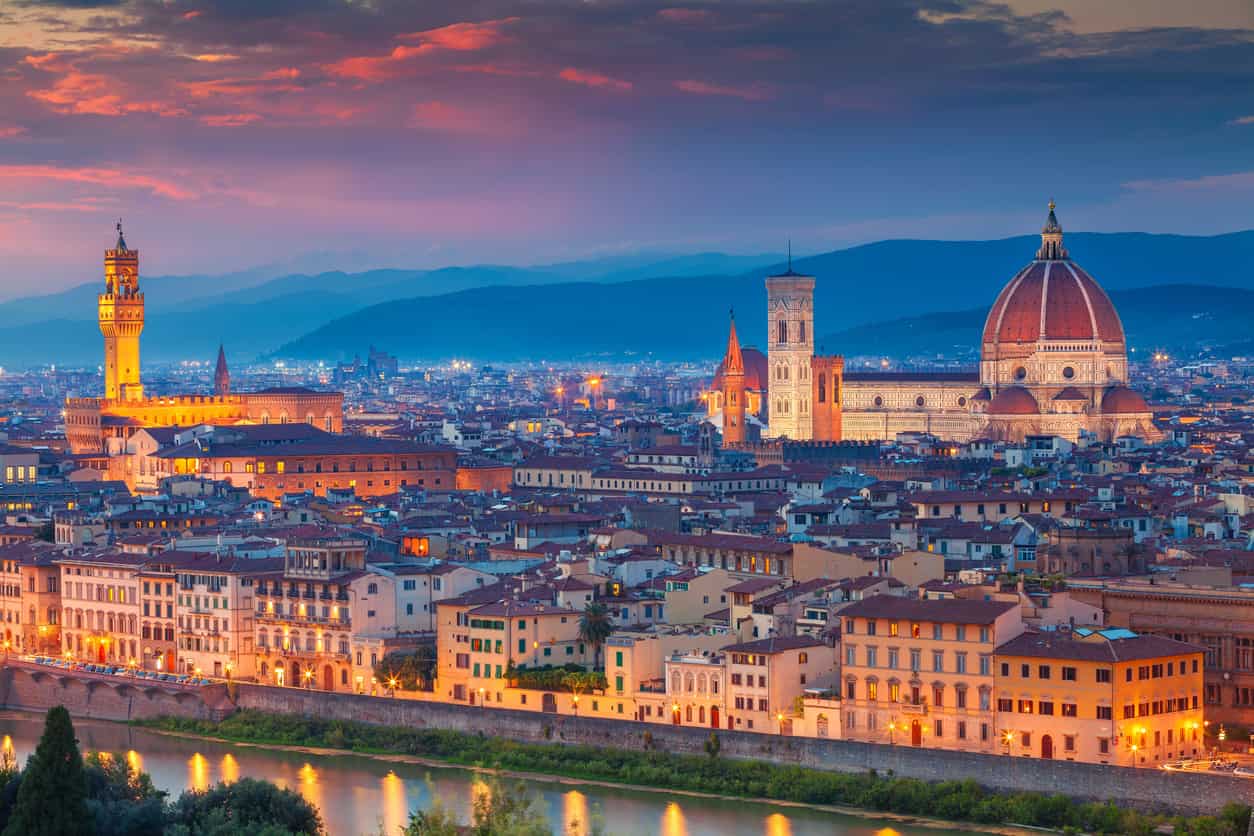
Birthplace of the Renaissance, Florence, Italy is home to Michelangelo’s David.
©iStock.com/RudyBalasko
Florence is one of the top five cities in Italy. As the capital city in Italy’s Tuscany region, Florence has no shortage of beauty. Florence is known as the birthplace of the Renaissance because of its beautiful artwork and artists such as Leonardo da Vinci. Home to things like the Duomo and Il David, it is no wonder that Florence is a commonly visited destination.
Typical Climate
Florence has a Mediterranean climate, meaning that it has hot summers but cold and wet winter months. If you want to avoid rain on your trip, don’t visit in spring. While the temperature may still be comfortable, rainfall is steady. In April, the average monthly rainfall is about 3 inches. Summer months — particularly July and August — offer the warmest and sunniest days. You are also much more likely to stay dry in these months, and the humidity is at its lowest. Autumn offers cooler days and high humidity, and the most rainfall occurs in late autumn. Winter shows consistent cool temperatures and a decent amount of rain as well.
Best Time to Visit and Natural Hazards to Be Aware Of
Considering the above climate, the best time to visit this region is summer. A common concern in Florence is flooding. One of the most tragic floods in the area was on November 4, 1966. That day, Florence received 25 percent of their annual rainfall in 24 hours; more than 66,000 gallons of water flowed throughout the city at a rate of 45 miles per hour. Besides that flood, they also had several other catastrophic floods in various years. There have been many projects created in an attempt to reduce the risk of flooding. Despite the best efforts, it is thought that a similar flood could occur soon, and if it did, the results would be just as — if not more — catastrophic than the damage from the floods of the past.
Lake Como
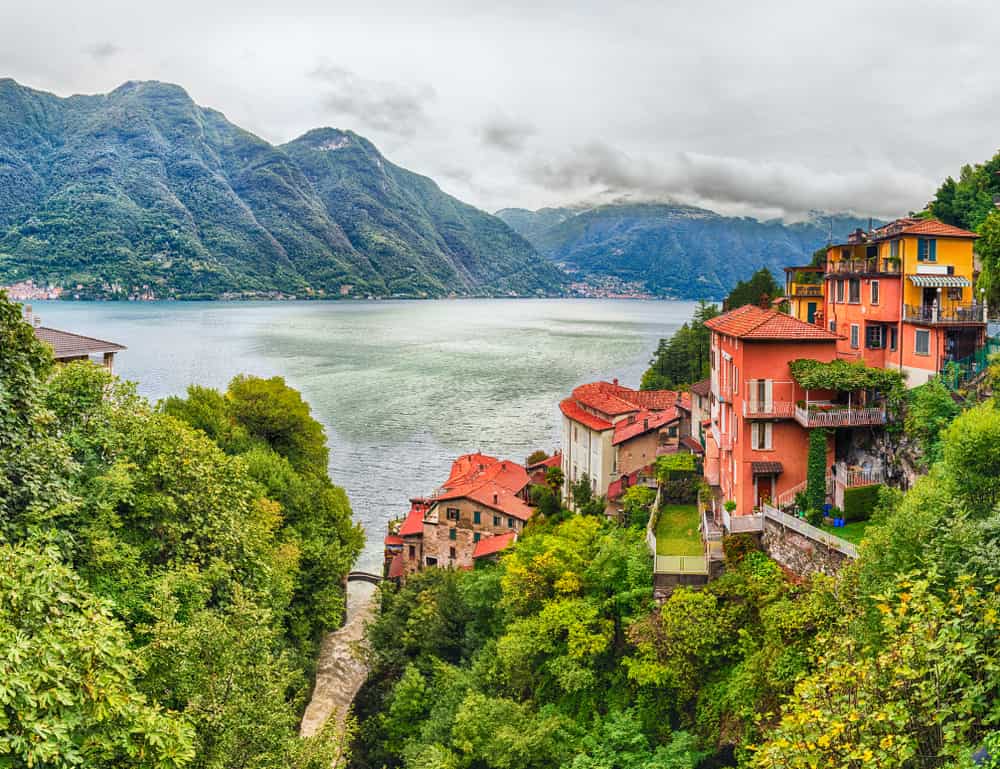
Bellano, Italy is one of the picturesque towns on Lake Como.
©Greens and Blues/Shutterstock.com
The beautiful Lake Como is located 650 feet above sea level in northern Italy. Due to the beautiful lake, the climate of Lake Como is milder and rainier than in the Po Valley. Known for hosting beautiful lakes, wildlife, and spas, it is no wonder that this incredible place is on the list of top tourist destinations in Italy.
Typical Climate
Lake Como has delightful weather, similar to the climate of Florence. Temperatures here average between 23-41 degrees Fahrenheit in the winter and 68-86 degrees Fahrenheit in the summer. However, each season offers its own unique weather patterns and charms.
In spring, the average high is between 62-70 degrees Fahrenheit. Rain is also widespread in this season, particularly in May. Summer is the most popular time for tourists because of its sunshine and warm temperatures. In June, temperatures reach up to 77 degrees, and in July and August, they reach 80 and higher. The cool waters of the lake offer a refreshing respite from the heat, and its beaches become increasingly popular in the summer months.
Autumn is a popular time as well because of the beautiful fall foliage. The average temperature is around 66 degrees in September and cools off to around 48 in November. Another benefit of the autumn months is that they tend to have less rainfall than the spring and summer months. Winter has the cooler temperatures, with the coldest month being January.
Best Time to Visit and Natural Hazards to Be Aware Of
Unless you enjoy cool air and the potential for skiing, winter is not the time to visit Lake Como, as it is not uncommon for temperatures to drop below zero during the nights. The best times to visit this incredible destination are between April and October.
One natural hazard to be aware of when visiting is tsunamis. Tsunamis are giant waves that are caused by sudden disturbances in the ocean. Things that can cause tsunamis are earthquakes, volcanoes, and landslides. In 2021, there was a nasty storm that affected Lake Como. Floodlist states, “Heavy rainfall raced down slopes around Lake Como, triggering landslides and flash floods on the communities below”. Storms like this one that occurred a few years ago are only one of the potential concerns for a tsunami.
In addition, the Department of Chemical and Environmental Sciences at the University of Insubria found a “major natural hazard” in the area. Due to major flood events, landslides, and other catastrophes, there is a significant change in the lake’s level and earthquake shaking. “These megaturbidite events registered in the Lake Como have an extraordinary volume and thickness for the lacustrine environment and represent a major natural hazard,” said Daniela Fanetti, author of the study. “Underwater mass movements, in fact, can provoke tsunami and seiches, water oscillations that can cause elevated damage along the lake shore.” In order to avoid any natural hazards in this area, you should try to avoid the rainy seasons.
Milan
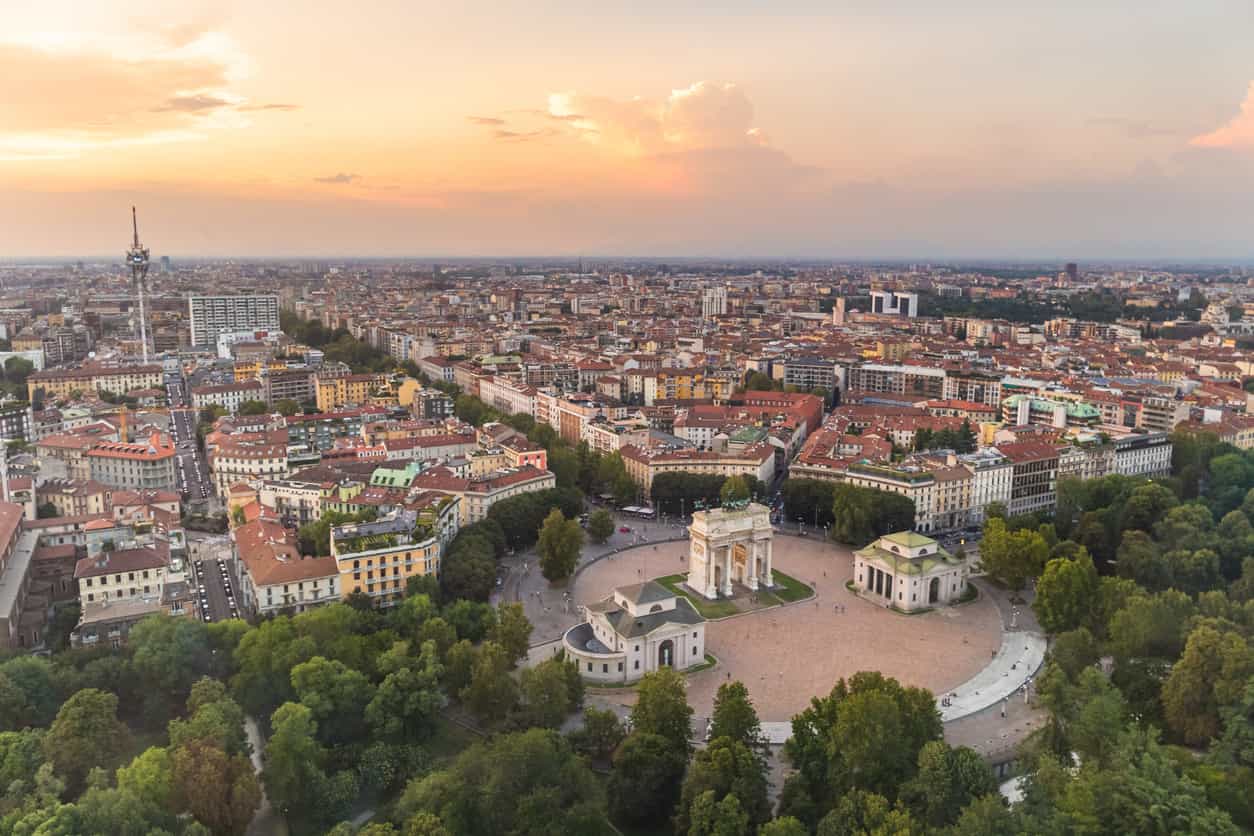
Milan has a varied climate, with temperatures ranging from 31 to 85 degrees Fahrenheit throughout the year.
©iStock.com/FedevPhoto
Located in Italy’s northern Lombardy region, Milan is another of the most popular cities to visit in Italy. Known for its impressive fashion and architecture, it is a popular tourist destination. Although it can be cloudy year-round, the temperatures vary significantly throughout the seasons.
Typical Climate
Summers are hot and humid, while winters are cold. Throughout the year, the temperatures usually range from 31 degrees Fahrenheit to 85 degrees Fahrenheit. The hot season lasts from early June to early September, with an average high of 77 degrees Fahrenheit. The cold season lasts from mid-November to late February, with an average high of 51 degrees Fahrenheit. July and January are the respective hottest and coldest months of the year. The wet season is between the end of March to mid-November, with May being the wetter month. The dry season is between the end of November and the end of March, with February being the driest month.
Best Time to Visit and Natural Hazards to Be Aware Of
Although it is visited throughout the year, this city’s prime visiting times are between April-May and September-October. This is mainly due to the pleasant weather during those months.
Milan has a low natural disaster risk. While it is prone to the same potential earthquakes and flooding that are found across Italy, natural hazards do not seem as high in this area.
Naples

Watching the sunset in Napoli (Naples) with a view of Mount Vesuvius is an unforgettable experience in Campania, Italy.
©bluejayphoto/iStock via Getty Images
Located in southern Italy in Campania, Naples is known for many things. One of the biggest things Naples is known for is that it is considered the birthplace of pizza! Besides the delicious tomato sauce and fluffy dough, this city is also known for its colorful neighborhoods and tons of history.
Typical Climate
Summers in Naples are short, warm, and dry. Winters are long, cold, and wet! Temperatures range from an average of 42-86 degrees Fahrenheit and rarely get below 35 degrees or above 92 degrees. The hot season is considered to be from mid-June to the center of September, while the cold season is from the end of November to the center of March.
Precipitation amount varies throughout the year. The wet season lasts from the middle of September to early May. In contrast, the dry season lasts from early May to the middle of September. The month with the most wet days is November — an average of 4 inches — and the driest month is July, with an average of 0.6 inches of rainfall.
Best Time to Visit and Natural Hazards to Be Aware Of
The best time to visit Naples is between March and May or between September and October, which will offer the most ideal temperatures.
A natural hazard in Naples is volcanoes. According to Natural Hazards and Earth System Sciences, “The Naples (Southern Italy) area has the highest volcanic risk in the World, due to the coexistence of three highly explosive volcanoes (Vesuvius, Campi Flegrei and Ischia) with extremely dense urbanization.” It is always a good idea to check local news sources before traveling to see the status of specific risk factors before traveling. Some warning signs that a volcano may erupt include bulging of the volcano, prolonged gas emission, and a sequence of earthquakes.
Rome

Rome has a varied climate because it has both coastal and inland regions. The inland areas have cooler winters but less humidity than the coastal regions.
©prochasson frederic/Shutterstock.com
Rome is known for more than being the capital of Italy. It is also home to famous structures like the Colosseum, the Trevi Fountain, and the Vatican City. Rome is unique in its geography, and that geography plays a prominent role in its climate.
Typical Climate
The coastal regions have milder winters but increased humidity — particularly in summer months — due to the proximity of the Mediterranean Sea. Rainfall is also lowest in the summer months. Temperatures average between 37-89 degrees Fahrenheit, with temperatures rarely below 28 degrees or above 95 degrees. The hot season is from the middle of June to early September, with an average daily high of 82 degrees. The cool season is from late November to the middle of March, with a daily high below 60 degrees. The hottest month of the year in Rome is August, and the coldest is January.
The wet season corresponds with the cooler season, which lasts from early September to the middle of May. The month with the most wet days is November. The dry season occurs from the middle of May to early September, with the driest month being July.
Best Time to Visit and Natural Hazards to Be Aware Of
The best times to travel to Rome for pleasant weather are between April and June or between September and early November.
Unlike its many well-known features, something that is not commonly known about Rome is its high risk of flooding and earthquakes. This city’s heavy rain and hilly nature pose a high risk for flooding and frequent landslides. It is also “built on loosely packed alluvial deposits originating from bodies of water,” thus meaning that if an earthquake does happen nearby, this loose earth amplifies the impact, and the city will be affected.
Sardinia

Castelsardo is a colorful town in Sardinia, Province of Sassari, Italy.
©Vladimir Sazonov/Shutterstock.com
Located west of mainland Italy, this Italian island is a paradise. It is a popular tourist destination, mostly known for its stunning beaches and turquoise seas.
Typical Climate
The hot season in Sardinia lasts from mid-June to the beginning of September, with the average daily high temperature of 82 degrees Fahrenheit. The cool season is from the end of November to the end of March, with the average daily high temperature of 64 degrees Fahrenheit. The hottest month here is August and the coldest month is January.
Sardinia has a more extended wet season than the dry season. The wet season lasts from the end of September to the beginning of May. In that time, there is a greater than 15 percent chance of any day being wet. The wettest month in the wet season is November. The dry season is between early May to the end of September. With an average of 0.6 days being considered wet, July is regarded as the driest month of the year.
Best Time to Visit and Natural Hazards to Be Aware Of
The best times to visit this beautiful destination for ideal weather are between April-May and September-October.
Unlike many other regions in Italy, Sardinia is not usually subjected to earthquakes. Instead, the natural hazard that plagues this place is wind storms and floods. The windstorms cause damage to trees, and the floods are a result of frequent and heavy rains. Try to travel there during the dry season to lessen your chance of being there during a flood.
Sicily
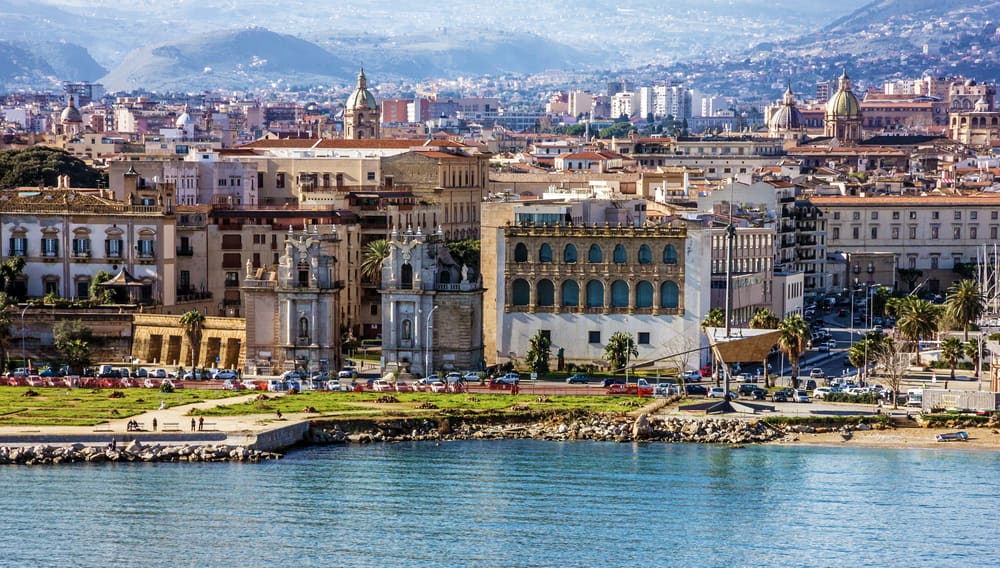
Palermo, Sicily, is a popular destination in Italy.
©Travel Faery/Shutterstock.com
Located at the tip of the “boot,” Sicily is the largest island in the Mediterranean. Sicily is known for its beautiful beaches, delicious food, and unique architecture. Sicily has a Mediterranean climate, with moderate temperatures, wet winters, and dry summers. However, its environment does vary between its inland and coastal regions.
Typical Climate
In the spring, the coastal regions have highs between 60-80 degrees Fahrenheit. Springtime lasts from March until May. The summertime has temperatures in the high 90s that last until early September. January is Sicily’s coolest month, and even then, temperatures do not drop below 50 degrees Fahrenheit. The inland regions are cooler than the coastal regions, usually about 15 degrees less. Precipitation is low in the summer; October, November, and December are the wettest months.
Best Time to Visit and Natural Hazards to Be Aware Of
The best time to visit depends on what you are coming to this island to do. Suppose you are interested in swimming in those turquoise waters and enjoying beach days. In that case, the summertime is the best choice. However, if you are coming to explore the island’s volcano, Mt. Etna, the best months to do so are May, June, September, and October.
Mt. Etna is the highest active volcano in Europe! While that might be an exciting activity to add to your tourist bucket list, it also poses a threat. It is considered one of the natural hazards of the island. This volcano does erupt several times a year and although experts monitor it, it is always a good idea to be vigilant. Excessive rainfall can impact volcanoes, so if you want to lessen your chance of being in Sicily when the volcano erupts, aim for the drier seasons.
Siena
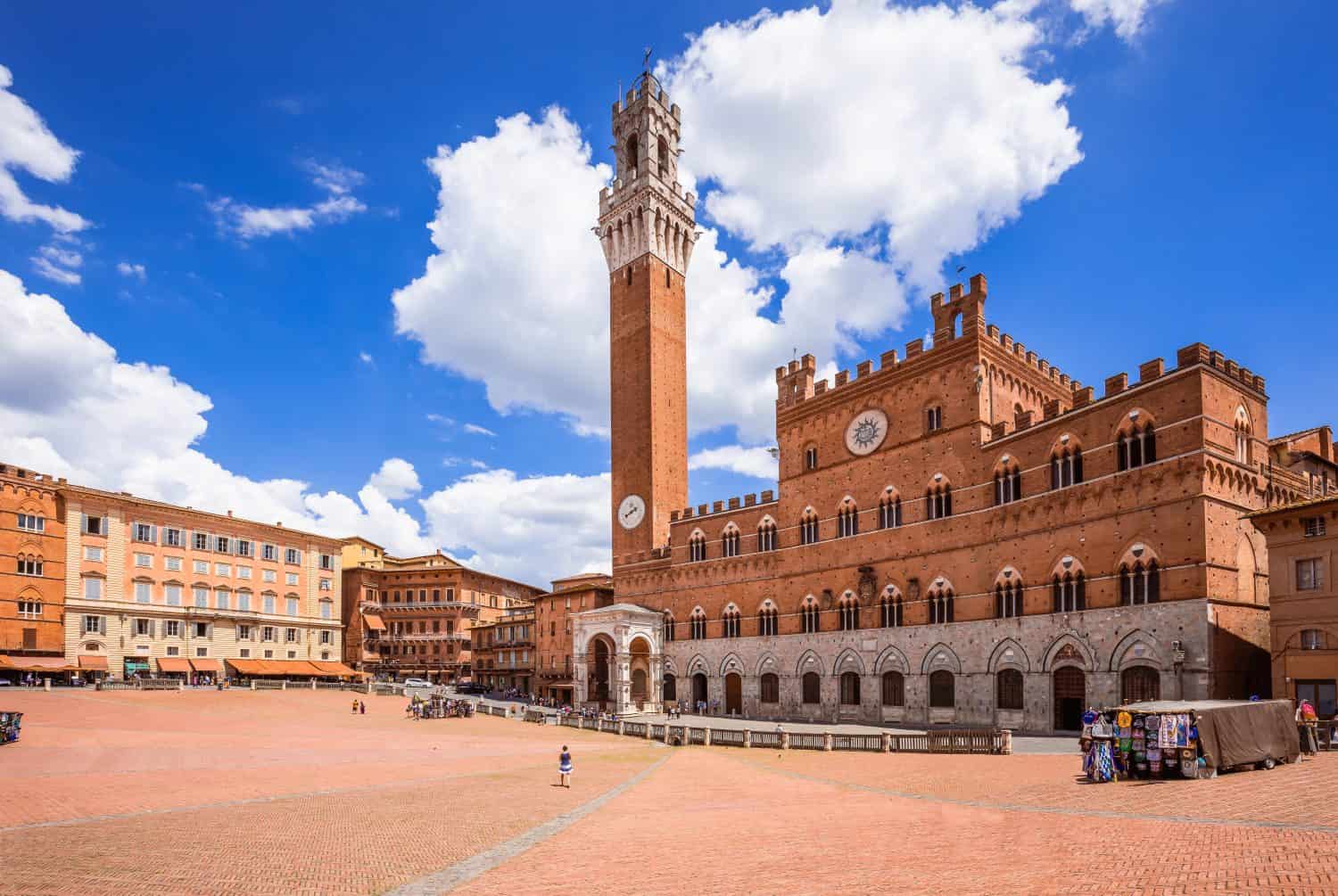
Piazza del Campo in Palazzo Pubblico and Torre del Mangia are famous gathering spots in Siena, Italy. Image: SCStock, Shutterstock
©SCStock/Shutterstock.com
Located about 56 miles from Florence, Siena is located in the Tuscany region of Italy. Siena is most known for its architecture and beautiful city streets. It is also home to the Piazza del Campo, where famous horse races are held.
Typical Climate
Summers in Siena are short, hot, and mostly cloudless. Winters are long, cold, and cloudy! Average temperatures throughout the year range from 32-88 degrees Fahrenheit, rarely getting below 21 degrees or above 95 degrees. The hot season lasts from the middle of June to the beginning of September, with an average daily high temperature of 80 degrees. The cold season is from mid-November to the beginning of March, with the average daily high temperature being 56 degrees.
The rainfall tends to follow the seasons. The summer months tend to be drier, with an average of 3.6 days a month being considered wet. The driest of the months is July. The winter months have a higher precipitation rate, with an average of 8.9 days a month being considered wet. The wettest month is November.
Best Time to Visit and Natural Hazards to Be Aware Of
The best time to visit is April to June and September to November. During these times, the weather is neither too hot nor too cold.
Regarding risk factors from natural hazards, Siena ranks low on the list. Although flooding does happen, and is common in other parts of Italy, Sienna has a minor risk of flooding over the next 30 years.
Sorrento

Sorrento lemons are used for making Italy’s famous limoncello. Image: IgorZh, Shutterstock
©IgorZh/Shutterstock.com
Located in the Campania region of Italy, this coastal Mediterranean city is another tourist hotspot. This city offers laid-back vibes, cobblestone streets, and delicious foods, it is no wonder this place is so well-loved. Summers here are hot, muggy, and dry, whereas the winters are cold, wet, and windy.
Typical Climate
The hot season lasts from the middle of June to the middle of September, with an average daily high temperature of 81 degrees Fahrenheit. The hottest month of the year is August. The cold season lasts from the end of November to the end of March, with an average daily high temperature of 63 degrees Fahrenheit. The wet season in this region lasts from early September to early May, with a greater than 23 percent chance of any given day in those months being considered a wet day. The dry season is from early May to the middle of September, with an average of only 2.5 days a month being considered wet days. The year’s wettest month is November, and the driest month is July.
Best Time to Visit and Natural Hazards to Be Aware Of
The best time to travel to Sorrento to experience ideal weather conditions is during May, June, September, and October. This region is at risk for various natural hazards. According to the International Journal of Disaster Risk Reduction, “Region Campania in Southern Italy presents an almost unique combination – in terms of both variety and intensity- of potential risk for the residents: this densely populated area is most notably exposed to hydrogeological (flood and landslide), seismic, volcanic hazards.” It is argued that there should be a constant increase in risk awareness for all those inhabiting this region, so be sure to check local sites and news before traveling here.
Tuscany
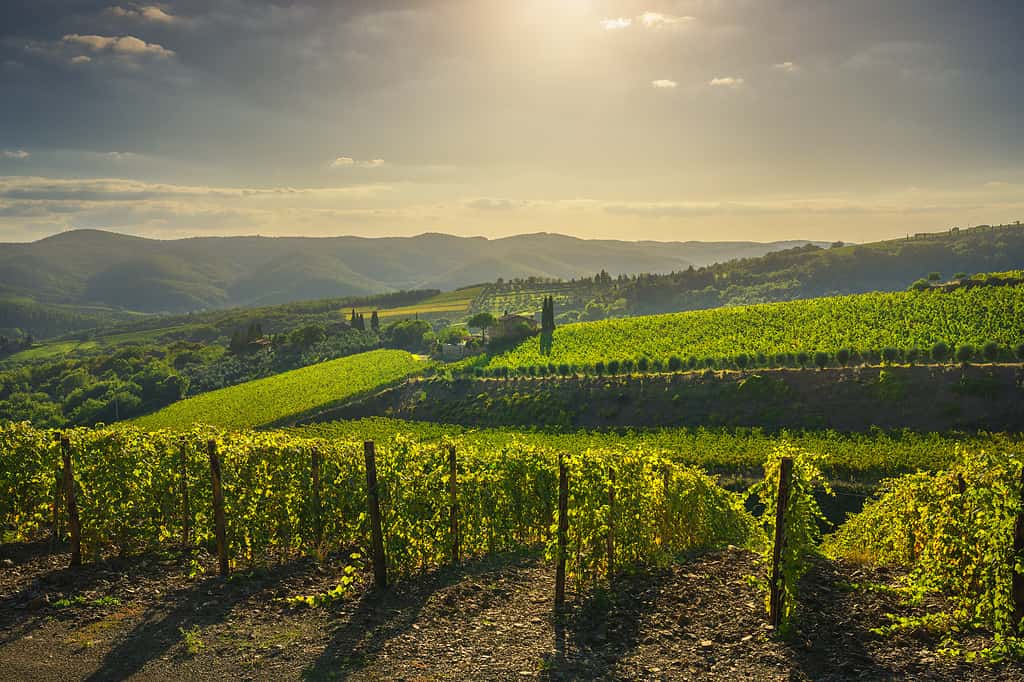
Tuscany has three distinct regions, a coastal region, an inland region, and a highland region.
©StevanZZ/iStock via Getty Images
Located in central Italy, this region is mostly known for its beautiful cities — Florence and Siena — and its many beautiful vineyards. Often referred to as wine country, Tuscany boasts beautiful hills and valleys. It also has coastal regions and mountain scenery. The variety of landscapes leads to a variety of climates in the region.
Typical Climate
In the coastal regions, a Mediterranean climate features hot, dry summers and mild winters. In the region’s center, there is a mix of Mediterranean and highland climates. Within the highland climates, there is a sharper contrast between the cooler winters and hotter summers.
September, October, November, and December offer the highest chance of precipitation, whereas July is the driest month. The warmest month in Tuscany is August, with an average temperature of 77 degrees Fahrenheit. The coolest month is January, with an average temperature of 41 degrees Fahrenheit.
Best Time to Visit and Natural Hazards to Be Aware Of
The best time to visit for ideal weather is in June; this is when you are most likely to experience good weather days with pleasant, mild temperatures.
Similar to Florence and Siena, the main source of concern in Tuscany is flooding. Different cities have different levels of risk factors depending on their landscapes, but the entire region should be alert. To reduce your risk of dealing with any flooding in this region, it is best to travel during the dry seasons.
Venice
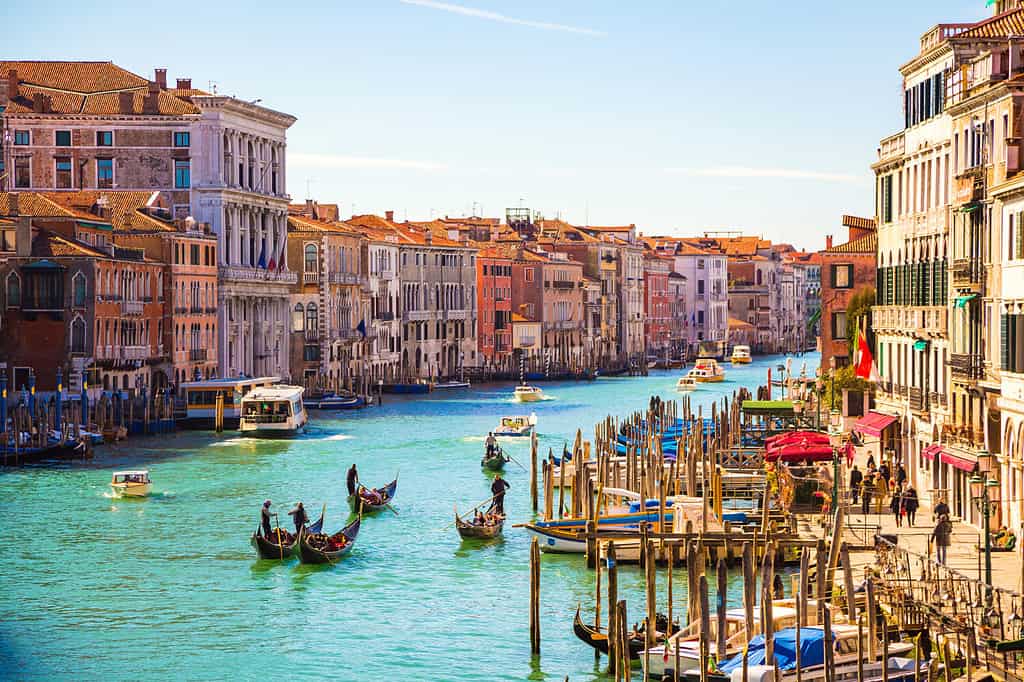
The many canals in Venice put it at an increased risk for flooding, as well as the lack of proper sewer and drainage systems.
©RAW-films/Shutterstock.com
Venice is one of the most well-known cities in Italy. Mostly known for its famous canals and gondolas, this impressive city is undoubtedly a sight to behold. Venice has a warm and temperate climate and has notable precipitation throughout the entirety of the year. Temperatures here typically vary between 33 degrees Fahrenheit and 83 degrees Fahrenheit.
Typical Climate
The warm season is from June to September, with an average daily high temperature of 75 degrees and above. The hottest month of the year is July. The cool season is from November to March, with an average daily high temperature of 52 degrees. The coldest month of the year is January. The wet season in Venice lasts about 7.8 months of the year.
The wet season lasts from the end of March to the end of November with a greater than 24 percent chance of any given day being considered wet. The wettest month is June, with an average of 8.6 days being considered wet days. The dry season lasts from the end of November to the beginning of March. January has the fewest wet days, with only an average of 5.3 days of the month being considered wet.
Best Time to Visit and Natural Hazards to Be Aware Of
The best time to visit Venice is during April, May, September, and October. During these months, you have the best chance of enjoying warm and dry weather.
Unsurprisingly, the main natural hazard in Venice is flooding. With the canals lining many of the streets, it is easy to see how flooding could occur so quickly. In addition to the canals, Venice also lacks proper sewer and drainage systems. This can be highly problematic when intense storms come through, and there is a surplus amount of water. With current climate situations worsening, the city aims to create solutions to help tackle these issues. To avoid any problems with flooding, it is best to plan your trip to this city during the dry season.
Summary of Italy’s Most Popular Destinations and When to Visit for Their Ideal Climates
Below is a table that reviews Italy’s top 15 most popular destinations and when to visit them for their ideal climates. You will find a summary of the destination, its location in Italy, its typical climate, natural hazards, and the best time to visit for ideal weather.
Top Locations and Their Climates
| Destination | Location | Typical Climate | Natural Hazards | Best Time to Visit |
|---|---|---|---|---|
| Amalfi Coast | Province of Salerno | Moderate warm temperatures | Landslides | During peak summer season. |
| Bologna | Emilia-Romagna region | Varied climate. Hot summers. Cool, damp winters. | Flooding | Summer and dry seasons. |
| Capri | Bay of Naples | Mediterranean climate with four distinct seasons. | Earthquakes | April to mid-June or the beginning of September to mid-October |
| Dolomites | Northeastern Italy | Varied climates across regions. | Deteriorating landscape. | Summer months July-September for hikes, winter months for skiing. |
| Florence | Tuscany Region | Mediterranean climate | Flooding | Summer months |
| Lake Como | Lombardy | Mediterranean climate | Tsunamis | Between April-October |
| Milan | Northern Lombardy | Varied temperatures | Occasional earthquake or flooding but low-risk | Between April-May and September-October |
| Naples | Campania | Varied climate | Volcanoes | Between March-May and September-October |
| Rome | Center of Italy, Lazio region | Varied climate due to different geographical locations | Flooding and earthquakes | Between April-June or September-early November |
| Sardinia | West of the mainland of Italy | “Paradise-like” climate | Wind storms and floods | Between April-May and September-October |
| Sicily | South of the Italian Peninsula (at the “tip of the boot”) | Mediterranean climate | Active volcano | For swimming and beach days: summer months For hiking and the volcano: May, June, September, October |
| Siena | Tuscany region (about 56 miles from Florence) | Varied climate | Flooding, but very low risk | From April-June and September-November |
| Sorrento | Campania | Mediterranean climate | Floods, landslides, volcanic hazards | May, June, September, and October |
| Tuscany | Central Italy | Variety of climates because variety of landscapes | Flooding | June for most ideal weather days |
| Venice | Veneto region | Varied climate | Flooding | April, May, September, and October. |
Thank you for reading! Have some feedback for us? Contact the AZ Animals editorial team.

